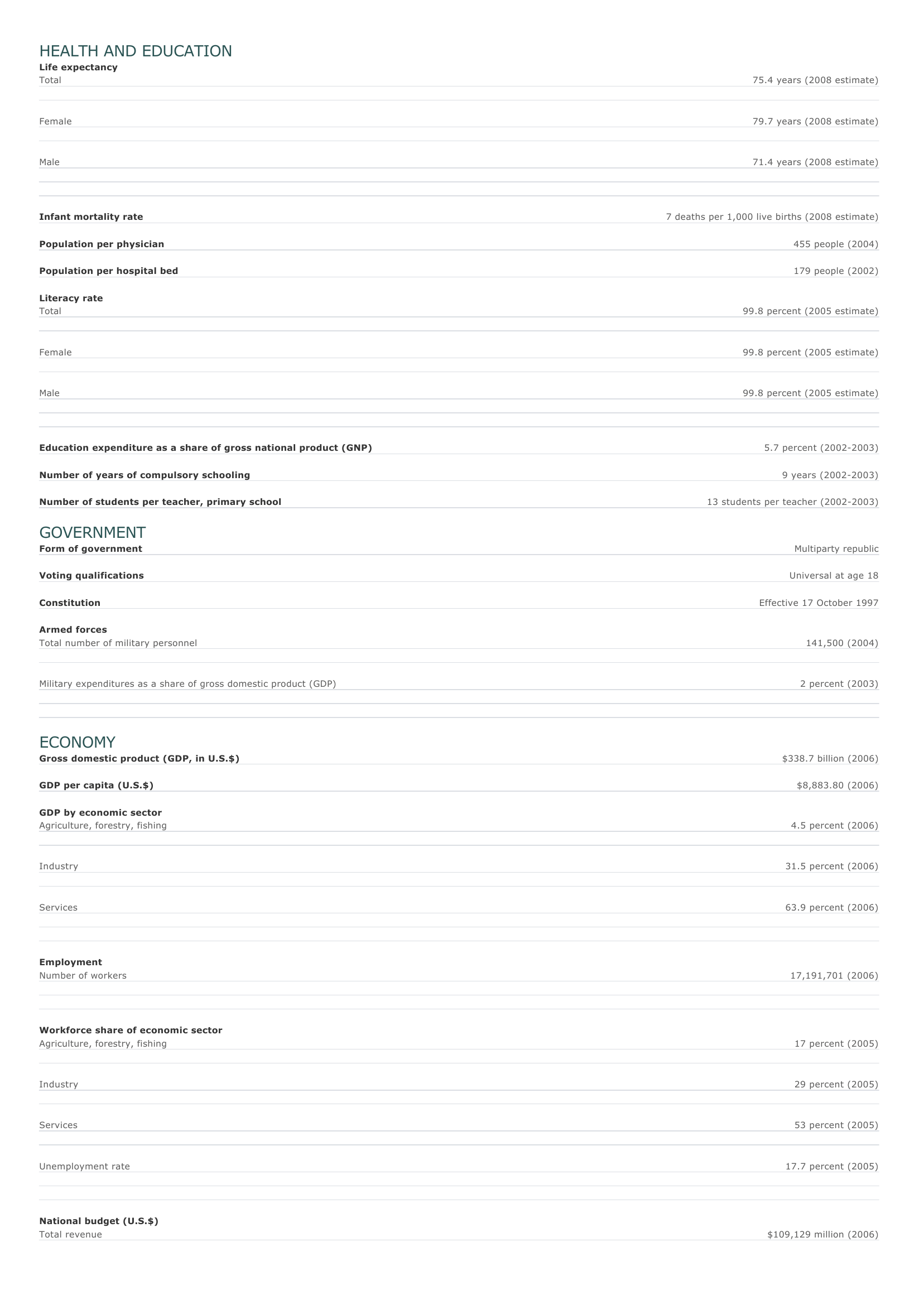Poland Facts and Figures. BASIC FACTS Official name Capital Area Republic of Poland Warsaw 312,684 sq km 120,728 sq mi PEOPLE Population 38,500,696 (2008 estimate) Population growth Population growth rate -0.04 percent (2008 estimate) Projected population in 2025 37,349,696 (2025 estimate) Projected population in 2050 32,084,570 (2050 estimate) Population density 127 persons per sq km (2008 estimate) 328 persons per sq mi (2008 estimate) Urban/rural distribution Share urban 62 percent (2005 estimate) Share rural 38 percent (2005 estimate) Largest cities, with population Warsaw 1,687,600 (2005 estimate) ?ód ? 760,251 (2007 estimate) K raków 756,267 (2007 estimate) Wroc?aw 634,630 (2007 estimate) Pozna? 564,951 (2007 estimate) Ethnic groups Polish 97.6 percent G erman 1.3 percent Ukrainian 0.6 percent Belarusian 0.5 percent Languages Polish (official), English, German, Russian Religious affiliations Roman Catholic 92 percent Orthodox Christian 3 percent Nonreligious 2 percent O ther 3 percent HEALTH AND EDUCATION Life expectancy Total 75.4 years (2008 estimate) Female 79.7 years (2008 estimate) Male 71.4 years (2008 estimate) Infant mortality rate 7 deaths per 1,000 live births (2008 estimate) Population per physician 455 people (2004) Population per hospital bed 179 people (2002) Literacy rate Total 99.8 percent (2005 estimate) Female 99.8 percent (2005 estimate) Male 99.8 percent (2005 estimate) Education expenditure as a share of gross national product (GNP) Number of years of compulsory schooling Number of students per teacher, primary school 5.7 percent (2002-2003) 9 years (2002-2003) 13 students per teacher (2002-2003) GOVERNMENT Form of government Multiparty republic Voting qualifications Universal at age 18 Constitution Armed forces Total number of military personnel Military expenditures as a share of gross domestic product (GDP) Effective 17 October 1997 141,500 (2004) 2 percent (2003) ECONOMY Gross domestic product (GDP, in U.S.$) GDP per capita (U.S.$) GDP by economic sector Agriculture, forestry, fishing $338.7 billion (2006) $8,883.80 (2006) 4.5 percent (2006) I ndustry 31.5 percent (2006) Services 63.9 percent (2006) Employment Number of workers 17,191,701 (2006) Workforce share of economic sector Agriculture, forestry, fishing 17 percent (2005) I ndustry 29 percent (2005) Services 53 percent (2005) Unemployment rate 17.7 percent (2005) National budget (U.S.$) Total revenue $109,129 million (2006) Total expenditure Monetary unit $122,476 million (2006) 1 zloty (Zl), consisting of 100 groszy Major trade partners for exports Germany, France, Italy, United Kingdom, and Netherlands Major trade partners for imports Germany, Russia, Italy, France, and United Kingdom ENERGY, COMMUNICATIONS, AND TRANSPORTATION Electricity production Electricity from thermal sources Electricity from hydroelectric sources Electricity from nuclear sources Electricity from geothermal, solar, and wind sources 98.11 percent (2003 estimate) 1.17 percent (2003 estimate) 0 percent (2003 estimate) 0.72 percent (2003 estimate) Number of radios per 1,000 people 522 (1997) Number of telephones per 1,000 people 309 (2005) Number of televisions per 1,000 people 401 (2000 estimate) Number of Internet hosts per 10,000 people 204 (2003) Daily newspaper circulation per 1,000 people 102 (2000) Number of motor vehicles per 1,000 people 354 (2003) Paved road as a share of total roads 70 percent (2003) SOURCES Basic Facts and People sections Area data are from the statistical bureaus of individual countries. Population, population growth rate, and population projections are from the United States Census Bureau, International Programs Center, International Data Base (IDB) (www.census.gov). Urban and rural population data are from the Food and Agriculture Organization (FAO) of the United Nations (UN), FAOSTAT database (www.fao.org). Largest cities population data and political divisions data are from the statistical bureaus of individual countries. Ethnic divisions and religion data are largely from the latest Central Intelligence Agency (CIA) World Factbook and from various country censuses and reports. Language data are largely from the Ethnologue, Languages of the World, Summer Institute of Linguistics International (www.sil.org). Health and Education section Life expectancy and infant mortality data are from the United States Census Bureau, International Programs Center, International database (IDB) (www.census.gov). Population per physician and population per hospital bed data are from the World Health Organization (WHO) (www.who.int). Education data are from the United Nations Educational, Scientific and Cultural Organization (UNESCO) database (www.unesco.org). Government section Government, independence, legislature, constitution, highest court, and voting qualifications data are largely from various government Web sites, the latest Europa World Yearbook, and the latest Central Intelligence Agency (CIA) World Factbook. The armed forces data is from Military Balance. Economy section Gross domestic product (GDP), GDP per capita, GDP by economic sectors, employment, and national budget data are from the World Bank database (www.worldbank.org). Monetary unit, agriculture, mining, manufacturing, exports, imports, and major trade partner information is from the statistical bureaus of individual countries, latest Europa World Yearbook, and various United Nations and International Monetary Fund (IMF) publications. Energy, Communication, and Transportation section Electricity information is from the Energy Information Administration (EIA) database (www.eia.doe.gov). Radio, telephone, television, and newspaper information is from the United Nations Educational, Scientific and Cultural Organization (UNESCO) database (www.unesco.org). Internet hosts, motor vehicles, and road data are from the World Bank database (www.worldbank.org). Note Figures may not total 100 percent due to rounding. Microsoft ® Encarta ® 2009. © 1993-2008 Microsoft Corporation. All rights reserved.






